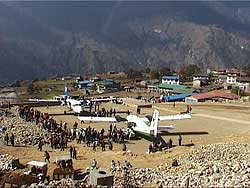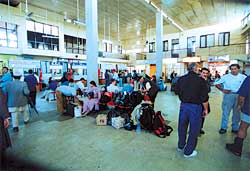 Just a few years ago Nepali domestic aviation was a model of successful deregulation. New airlines were popping up every week, services were getting better, and even the price of tickets had started going down.
Just a few years ago Nepali domestic aviation was a model of successful deregulation. New airlines were popping up every week, services were getting better, and even the price of tickets had started going down. Today it is all in shambles. Buffeted by a tourism slump that started with the Indian Airlines hijack in December 1999 and carried on to the post-11 September worldwide downturn, Nepal's domestic airlines are struggling to stay aloft.
The impact of the policy of opening up the skies was there for all to see:
. The number of Nepalis flying internally jumped almost five times from about 350,000 in 1992/93 to 1.8 million last year.
. Domestic airlines hauled a million tonnes of cargo last year, compared to half that amount in 1992.
. Last year there were 19 private airlines flying, compared to only Royal Nepal Airlines ten years ago.
. The government had given air operator certificates to 31 airlines by 2000.
To be sure, most of the aircraft in the domestic field are second-hand, safety standards have not been up to mark with a series of tragic crashes. But tourists and Nepali passengers have benefited. There are now more than 20 flights a day between Kathmandu and Pokhara, about 15 a day to Lukla. There are no waits for flights to Jomsom or Bhairahawa. However, airlines have not made much of an impact in remote, non-profitable sectors like Jumla, Bajhang or Taplejung. Private airlines that do venture out to these routes are known to charge double, sometimes triple, the Royal Nepal Airline's rate on the sly.
There were already serious problems with undercutting and unhealthy competition for passengers and the domestic airline industry was getting ready for a shakeout. There were talks of mergers and acquisitions. Also, as the airline industry generates quick revenue that is where fly-by-night investors would want to be. Anyone with just enough money to buy/lease two aircraft can join and these would be the first to leave when the downturn begins.
But the crisis in tourism has made matters much worse and much faster than anyone imagined. Now, the challenge is staving off bankruptcy. A tourism slump had hit nearly all private airlines and they had pinned their hopes on the autumn season. But the cancellations after 11 September and the strikes against Afghanistan have spooked all except the most determined tourists.
"We just don't have enough people flying," said Lt Col (retd) Narayan Singh Pun, who took over as Chairman and Managing Director of Necon Air last month. "Necon has big problems, almost close to shutting down if things don't improve."
Necon's losses over the past few years have ranged between Rs 100-120 million and revenues are now sliding even faster. According to Pun, Necon's monthly earnings average around Rs 40 million, while the operation cost is to the tune of Rs70 million.
No business can run with such statistics but industry analysts suspect the situation is similar for others in the business, but they do not disclose their numbers as easily. When Pragyan S. Rana of Mountain Air was asked why the airlines were still flying. "We have no choice," he shot back. "We have to get as close to break even hoping that things will improve."
Necon has been trying to cut costs by taking on a smaller partner-in a marketing alliance-but the process remains caught up in employee resistance and other procedural hold-ups.
 There are just too many reasons for the problems nagging the industry. First is oversupply of seats, especially to the main hubs and the tourist routes, which has triggered steep undercutting in the already low fares. Necon's latest rates, sent to travel agents two weeks ago, offer a mountain flight in an ATR plane for as low as $1400. In a full-occupancy scenario this translates into a ride to Mount Everest and back for as little as $32, almost 60 percent below the government-approved rates. It is a different matter that passengers may not actually get tickets that cheap because the travel agents pocket the difference.
There are just too many reasons for the problems nagging the industry. First is oversupply of seats, especially to the main hubs and the tourist routes, which has triggered steep undercutting in the already low fares. Necon's latest rates, sent to travel agents two weeks ago, offer a mountain flight in an ATR plane for as low as $1400. In a full-occupancy scenario this translates into a ride to Mount Everest and back for as little as $32, almost 60 percent below the government-approved rates. It is a different matter that passengers may not actually get tickets that cheap because the travel agents pocket the difference.
The problem with all operators is that they are already so deep in debt and commitments that it is almost impossible to close shop and walk out. If low tourism is one reason for the downturn the other-larger-problem is government, and the incomplete liberalisation of domestic aviation. By law, the government fixes the fares, which have not been revised since 1993 while prices of everything from spares, insurance and fuel, and parking and landing fees have increased several times. The insurance premiums have also doubled since the last fare revision-not to mention the new coverage airlines have to seek to protect themselves from possible terrorist attacks.
Some of the existing domestic fares are just unbelievably low and operators say they don't cover the costs even at 100 percent occupancy. One example is the rate from Biratnagar to Tumlingtar, which costs Rs 400 for a 20-minute flight. Because the rates, especially to the remote destinations are so unrealistic, most private operators stay away from them, forcing the government-run Royal Nepal to service the routes-and dig deeper into its losses.
Government fixes the fares and airlines have freedom to manoeuvre rates within a 30-percent range above and below the approved rates. Now, even that does not seem to matter because the companies are desperate to sell for anything as long as it ensures a sustained cash flow. "The rates and the undercutting now underway is not doing any good to anyone but when survival is at stake and cash flows are low many don't have a choice," says Upendra Karki of Cosmic Air. "Essentially private airlines make money by flying tourists, now there are not many of them to fly."
The increasing losses and the rush to keep cash boxes ringing could be a recipe for potential disaster the moment cost cutting concerns override security and safety spending. The government does not seem aware of the impending crisis. The spokesman at the Tourism Ministry did not know if the government was doing anything to avert the situation. "There has been no decision on revising the fares yet and I can't tell you if the Ministry is working on it," he said.
"We will operate as long as the direct costs are met," said Birendra Basnet of Buddha Air. He added that his smaller aircraft have given him more operational flexibility but increases in running costs threaten to be back-breaking. "If tourism collapses, then we'll be the next to go because whatever we earn today comes from tourists."
The overall tourism situation looks bleak. Pre-WTC attacks arrivals in September were down by 29 percent; the Indian share had gone down even further-by almost 44 percent. Large tour operators and hotels had their first round of cancellations after the attacks in New York and Washington. Now with the outbreak of war, more bad news may be coming their way. "We don't know how bad things could get, it's wait and see for now," a hotel operator said.
Flying in Nepal is hardly a luxury; only 58 of the country's 75 districts have road connections and many of them are motorable only in the dry seasons. It is more of a daily necessity and the one reason the government justifies its grip on the fares and why there are such cheap rates for flights to remote destinations.
"It's all right to have low fares but that should not be at the expense of the private investors," a private operator told us. "The one way that can work is to subsidise the fares but pay the difference between our operational cost and revenue or give us a freer hand at pricing in sectors where people can pay."
Old habits die hard in the bureaucracy, which can sit on vital commercial decisions for years such as the issue of fare revision. Politicians are also less interested to push such a decision, unlike, say, one for leasing a jet for Royal Nepal.
"They tell us they are aware of the problems we're facing but just don't decide," says Pun, who has already injected about over Rs 70 million into Necon. "But there is a limit to how far an investor can go."


